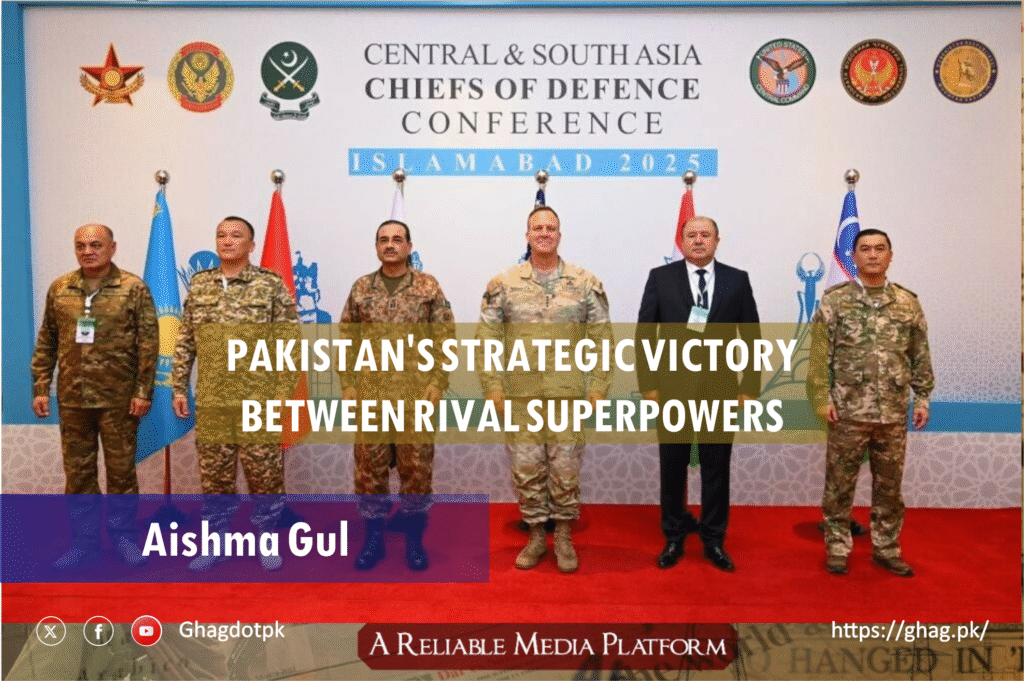By Aishma Gul
“In an era defined by transnational threats and complex hybrid challenges, Pakistan remains fully committed to working with partner nations to build a secure and prosperous regional environment,” said Field Marshal COAS Syed Asim Munir during Islamabad’s historic regional defense conference in July 2025. This statement shows Pakistan’s remarkable change from being isolated after 2021 to becoming the center of competition between the United States and China. Both superpowers now see Pakistan as crucial for their interests.
Why America Needs Pakistan?
The United States wants Pakistan back for several important reasons that go beyond normal partnerships. Pakistan proved its value when it caught and sent back the person behind the August 2021 Abbey Gate bombing in Kabul. This attack killed 13 American soldiers. Trump had promised to catch those responsible. Pakistan delivered, and Trump praised them in his speech to Congress. This showed Pakistan can track down international terrorists. US CENTCOM Commander General Michael Kurilla called Pakistan a “phenomenal partner in counterterrorism.” This shows how valuable Pakistan is in many ways.
The partnership also covers business interests. Pakistan embraced cryptocurrency and critical minerals, which fits perfectly with Trump’s technology and economic goals. Companies linked to the Trump family signed deals with Pakistan’s new crypto council. This mixes policy with business interests and makes ties stronger. The IMF released $2 billion to Pakistan on the same day the May ceasefire happened. This suggests America coordinated its financial moves to counter China’s growing influence.
Pakistan also helps keep the region stable. The country hosted its first defense conference with many nations since 2021. On July 26, military leaders from Central Asian countries came along with US commanders. This makes Pakistan look like a force for stability in a dangerous region where America faces more challenges. The conference led to agreements on deeper joint training, fighting terrorism together, cyber-security and disaster response. These create frameworks that help broader US goals.
Why China Values Pakistan?
For China, Pakistan means much more than just business investment. It’s the cornerstone of China’s Belt and Road project and a key gateway to the Arabian Sea. The China-Pakistan Economic Corridor (CPEC) is worth $62 billion since 2015. It gives China access to global sea routes while avoiding the Malacca Strait bottleneck that rival powers could control.
China rolled over a $3.4 billion loan to Pakistan in 2025. This shows Beijing wants Pakistan’s economy to stay stable. But the strategic reasons go deeper. During the May 2025 India-Pakistan conflict, Pakistan used 44 Chinese satellites for spy intelligence. This gave Pakistan real-time advantages and shows how connected the two countries are technologically. This intelligence sharing makes Pakistan a strategic asset for China’s bigger Indo-Pacific plans.
The Gwadar Port is under Chinese control near the Strait of Hormuz. This gives Beijing access to deep-water naval operations. This capability changes the balance of power in the Indian Ocean in a big way. Despite local Baloch worries about economic control by outsiders, China stays committed. Chinese Vice President Han Zheng recently said China and Pakistan are “ironclad friends and all-weather strategic cooperative partners marked by high-level mutual trust, solidarity through challenges, and a shared future.” This shows Beijing’s long-term strategic thinking.
China has also helped Pakistan diplomatically. It protected Pakistan from FATF grey-listing and defended Pakistan’s Kashmir position at the UN. This support goes beyond business cooperation to include full strategic partnership. The relationship includes defense cooperation through joint training, fighting terrorism together, and defense upgrades that improve how different military services work together.
Why Pakistan Needs Both Powers?
Pakistan’s diplomatic strategy shows smart thinking. Picking only one superpower would hurt Pakistan’s independence and economic stability. The country needs Chinese investment and infrastructure to fix its economic problems. At the same time, American security cooperation and international respect remain important for regional stability.
The economic side is especially important. China has provided loans, infrastructure investment, and technology cooperation since US aid stopped in 2021. That’s when Washington cut $1.3 billion in security aid.
Pakistan’s approach to Iran shows this balanced strategy. Foreign Minister Ishaq Dar announced that Iranian President Masoud Pezeshkian will visit Islamabad “soon,” likely in early August 2025. This shows Pakistan’s commitment to regional diplomacy despite American concerns. Dar criticized both Israeli attacks and US strikes on Iranian nuclear facilities. He took a principled stand: “Pakistan cannot remain indifferent to a wrongful act, even if it is carried out by a friendly country.”
This balanced approach lets Pakistan work as a mediator and bridge-builder. The country’s UNSC presidency in July 2025 was its first since 2013. It got unanimous approval of Resolution 2788 on peaceful dispute resolution. This showed Pakistan’s helpful role in working with many countries. Pakistan is also trying to get a seat on the 2026–28 UN Human Rights Council. This shows its commitment to working with international organizations.
Personal Diplomacy and Trump’s Methods
The personal side of Pakistan’s diplomatic success connects with Trump’s broader approach to international mediation. This creates a template that goes beyond just bilateral relationships. Trump likes “power figures” like Field Marshal Asim Munir. This is different from his complex relationship with Indian Prime Minister Modi. This helped Pakistan’s diplomatic breakthrough. COAS’s historic White House lunch was the first solo meeting between a sitting US president and a Pakistani military chief. This showed how personal chemistry turned into strategic gains.
This personal approach fits with Trump’s business-like diplomatic style. He showed this clearly when he got involved in the Thailand-Cambodia border conflict in July 2025. When facing a border clash that caused 30+ deaths and displaced 168,000+ people, Trump threatened up to 36% tariffs on both countries’ imports starting August 1 if fighting continued. This was similar to his claimed role in the May 2025 India-Pakistan ceasefire. When he talked to Thai PM Srettha Thavisin and Cambodian PM Hun Manet, he mentioned the India-Pakistan conflict. This shows how Pakistan’s successful ceasefire became a template for his broader conflict resolution strategy.
Pakistan acknowledged US mediation while India disputed Trump’s role. This shows Islamabad’s smart handling of great power relationships. Pakistan nominated Trump for the 2025 Nobel Peace Prize for his ceasefire efforts. This further shows strategic alignment with Trump’s personal diplomatic style.
China’s View and Concerns
Professor Victor Gao’s recent webinar comments give important insight into China’s view of Pakistan’s diplomatic balancing act. He said “both China and the United States owe gratitude to Pakistan for the foundation of their relations.” This was one of the most important diplomatic breakthroughs in modern history. Gao called Pakistan’s mediation “an exemplary model of diplomacy” that helped “fostering global development and peace.”
Some experts suggest China’s concerns about Pakistan’s closeness to Trump reveal deeper worries. Beijing fears that the deals on critical minerals and cryptocurrency might take Islamabad’s attention away from China-backed infrastructure projects. Closer US ties could shift Pakistan’s Middle Eastern diplomacy in areas where China has expanded its presence.
But Gao’s strong statement that “no country holds more importance for China than Pakistan” and his promise that Pakistan’s “enemies would never succeed in destabilizing it” shows China knows Pakistan’s strategic value goes beyond current diplomatic moves. His specific rejection of Baloch separatism was clear: “The dream of independent Balochistan will always remain a dream.” This shows China’s commitment to Pakistan’s territorial integrity as basic to Chinese strategic interests.
Regional Effects on South Asia
Pakistan’s diplomatic success has created big complications for regional power dynamics. This particularly affects India and Afghanistan in connected ways. New Delhi finds itself “sidelined” in the current setup. This is partly because of its quiet response to Trump’s ceasefire claims. While India keeps strong strategic and trade ties with the United States, Pakistan’s alignment with Trump’s specific priorities has created unexpected leverage. This complicates India’s own great power relationships. Pakistan showed it can access Chinese intelligence while maintaining US counterterrorism cooperation. This shows strategic flexibility that India struggles to match with its more rigid alliance commitments.
For Afghanistan, Pakistan’s expanded diplomatic engagement has big effects on post-withdrawal stability. The country’s counterterrorism cooperation with the United States, combined with its channels to regional actors, makes it a crucial player in managing Afghan dynamics. The July 2025 regional defense conference brought together Central Asian military leaders with US commanders. This creates frameworks for addressing shared concerns about militancy spillover and drug trafficking that directly affect Afghan stability.
This approach with many countries addresses threats that cross borders. No single bilateral relationship can manage these effectively. This makes Pakistan an essential part of regional security architecture that covers both South and Central Asia. Pakistan’s expansion of ties with Bangladesh and Turkey further strengthens its independence while creating additional complications for India’s regional influence.
Economic Strategy Beyond Aid
Pakistan’s current diplomatic approach goes beyond traditional aid-seeking relationships. Instead, it focuses on creating strategic value and mutual dependency. The country embraced cryptocurrency laws that aligned with Trump’s technology agenda. At the same time, it hosted high-profile UNSC events on Palestine that showed helpful leadership with many countries. Foreign Minister Dar’s meetings with US Secretary of State Marco Rubio focused on bilateral trade, investment, agriculture, technology, and critical minerals. This moved beyond security cooperation toward complete economic partnership.
Pakistan’s strategic positioning has attracted recognition of its broader diplomatic contributions. The giving of Nishan-i-Imtiaz (Military) to US CENTCOM Commander General Kurilla praised his role in “advancing enduring military cooperation.” This symbolizes making Pakistan’s strategic partnerships permanent beyond personal relationships.
Pakistan has also maintained strong ties with superpower Russia and recently saw Australia welcome mining partnerships with Pakistani companies – another smart move that shows Pakistan’s growing global reach.
What Comes Next?
Pakistan’s diplomatic comeback represents a masterclass in navigating great power competition through creating strategic value rather than choosing alignment. By becoming essential to both Washington and Beijing while maintaining regional partnerships, Pakistan has positioned itself as an architect of regional stability. This includes the upcoming Iran engagement and expanded ties with Bangladesh and Turkey. Pakistan is not just receiving great power attention anymore.
The country’s success lies in recognizing that in an era of many power centers, middle powers can achieve independence not through choosing sides. Instead, they become bridges that rival powers need to cross. Professor Gao’s acknowledgment of Pakistan’s historic role in China-US relations combined with today’s recognition of its strategic value shows how countries can use their unique positions. They can maintain relevance across changing international setups.
Pakistan changed from a side player struggling with international isolation to a central diplomatic hub. This shows how smart foreign policy can turn geographical limits into strategic advantages. The country’s ability to serve both superpowers’ interests while maintaining principled positions on issues like Iran shows a mature diplomatic approach. This creates lasting strategic capital beyond immediate business benefits.
This approach has created a model for other nations navigating similar great power pressures in an increasingly complex international system. The ability to provide unique value to competing powers may prove more lasting than traditional alliance structures. This ensures national security and prosperity in ways that older approaches cannot match.






